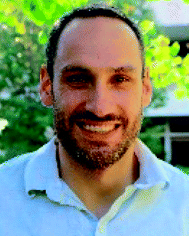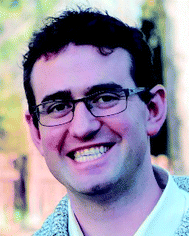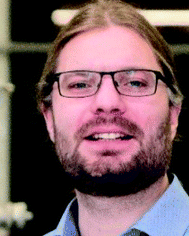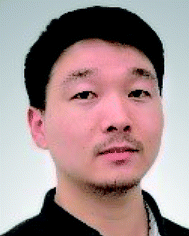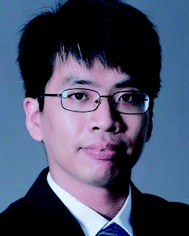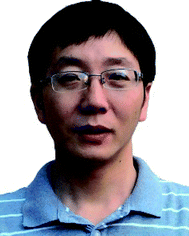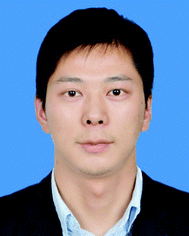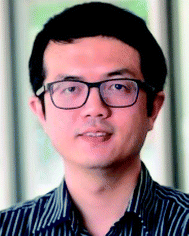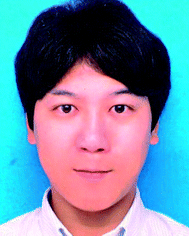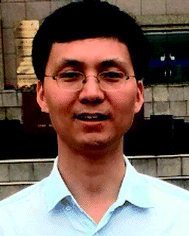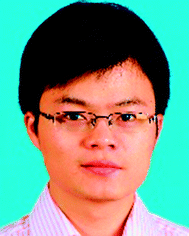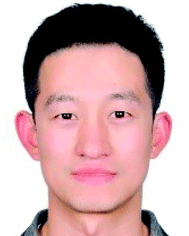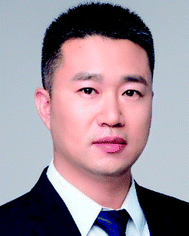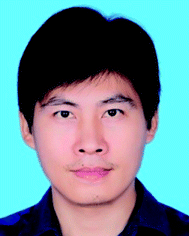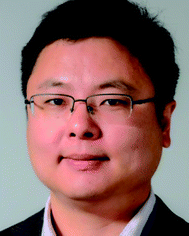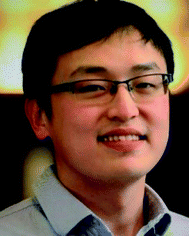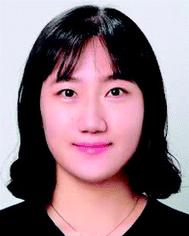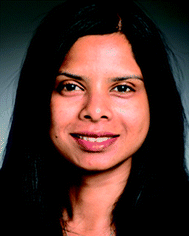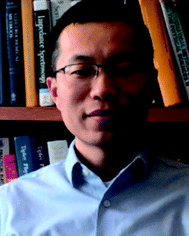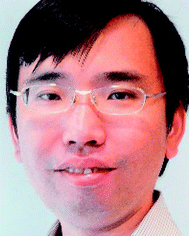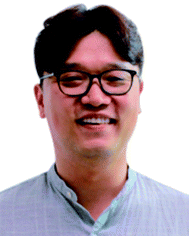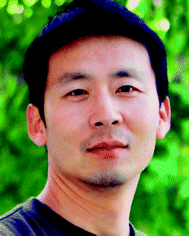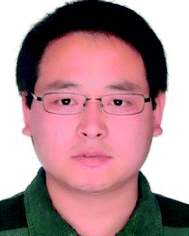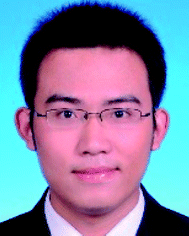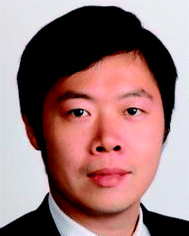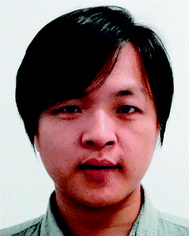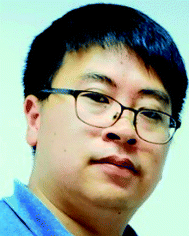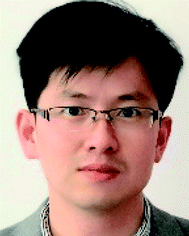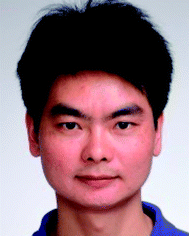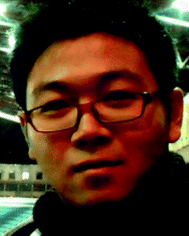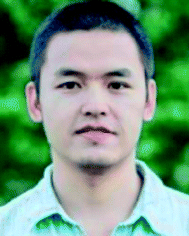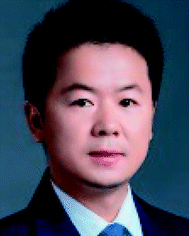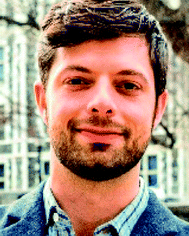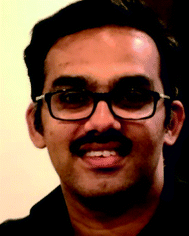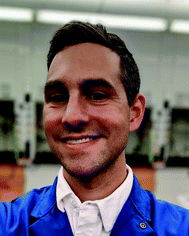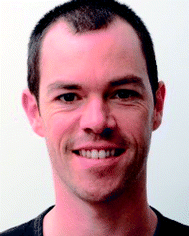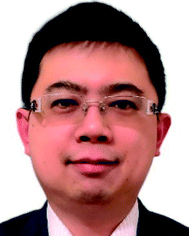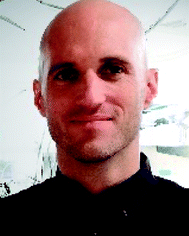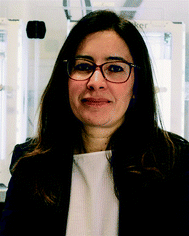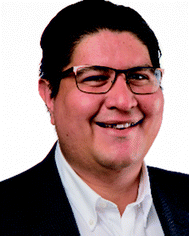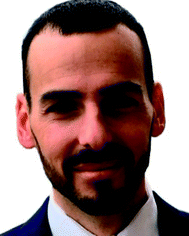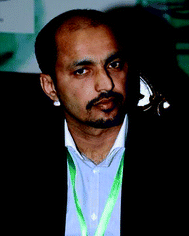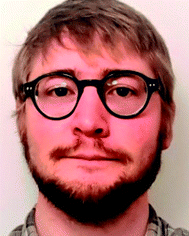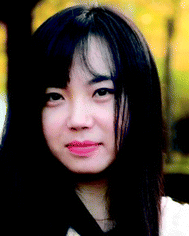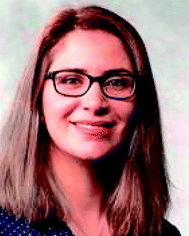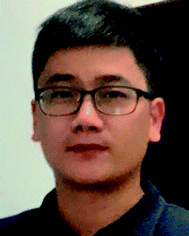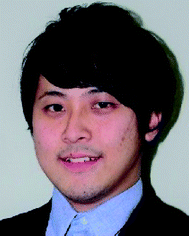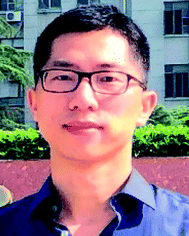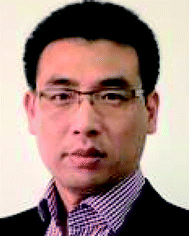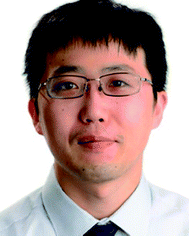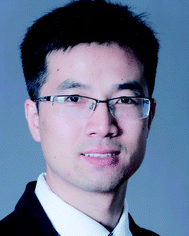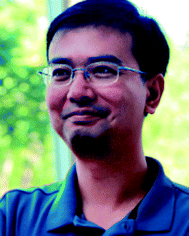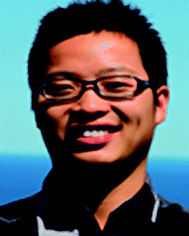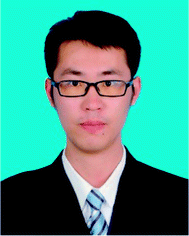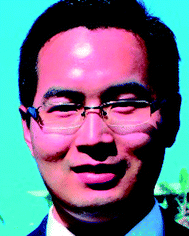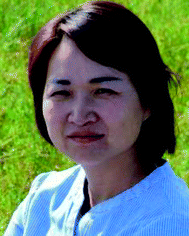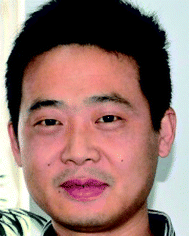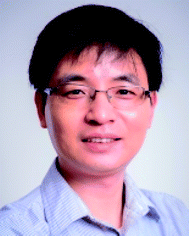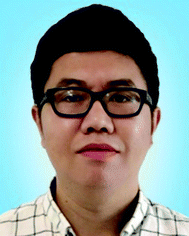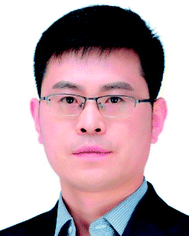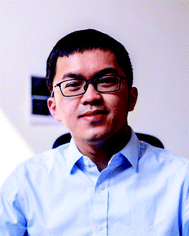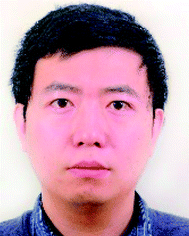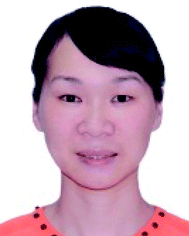DOI:
10.1039/D0TA90163F
(Profile)
J. Mater. Chem. A, 2020,
8, 15213-15226
Contributors to the Emerging Investigators 2020 issue
Abstract
Our 2020 Emerging Investigators themed issues gather some of the best research being conducted by scientists in the early stages of their independent career. Each contributor was recommended as carrying out work with the potential to influence future directions in materials chemistry. Congratulations to all of the researchers featured, we hope you enjoy reading this issue.
Dr John Anderson graduated with a B.S./M.S. in 2008 from the University of Chicago working with Greg Hillhouse on phosphine complexes of Ni and their reactivity with small molecules. He began his PhD at MIT and finished at CalTech in 2014 with Jonas Peters working on an Fe catalyst for nitrogen fixation. John then did a post-doc at Northwestern with Dave Harris focusing on materials, particularly metal organic frameworks. He returned to the University of Chicago in 2015 and has been interested in linking the physical characteristics of transition metal centers, including spin and radical character, to reactivity and materials properties.
Dr Chris Arges is the Gordon A. and Mary Cain Assistant Professor in the Cain Department of Chemical Engineering at Louisiana State University (LSU). His research interests lie at the confluence of polymer science and electrochemical engineering. Chris is the recipient of 3M’s Non-Tenured Faculty Award and LSU’s Rising Faculty Research Award. His research has been sponsored by NSF and the U.S. Department of Energy. Prior to starting his independent career at LSU, Chris was a Postdoctoral Fellow in the Pritzker School of Molecular Engineering at the University of Chicago.
Dr Munkhbayar Batmunkh is a research fellow in the Centre for Clean Environment and Energy (CCEE) at Griffith University, Australia. He also worked as a postdoctoral researcher at the University of Queensland (2018–2019) and Flinders University (2017–2018), both in Australia. He received his PhD in Chemical Engineering from the University of Adelaide (Australia) in mid-2017. He obtained his “Master of Engineering” degree from Gyeongsang National University, in South Korea, in 2012. He completed his “Bachelor of Science” degree in Chemistry at the National University of Mongolia, in Mongolia, in 2010. His research interests focus on the production of functional nanomaterials (
e.g. nanocarbons and 2D materials) for energy related applications such as solar cells and catalysis.
Dr Olaf Brummel studied Chemistry and received his PhD from the Friedrich-Alexander-Universität (FAU) Erlangen-Nürnberg, Germany. He did his Diploma in cooperation with Siemens AG and completed several research stays,
inter alia, at Leiden University (Netherlands) and the University of Guelph (Canada). He finished his PhD with distinction in 2018 and received the Gerda-Weller Award. Since 2018 he has been the work group leader for ‘Model Electrocatalysis’ at the Chair of Interface Research and Catalysis at FAU. Since 2016, he has been the coordinator of the DFG Research Unit FOR 1878. In his research, he applies and develops (photo)electrochemical
in situ techniques to explore model systems for energy conversion and electrocatalysis.
Dr Dongliang Chao obtained his PhD from Nanyang Technological University (NTU, Singapore). He joined University of California, Los Angeles (UCLA, USA) in 2016 as a joint-researcher, followed by a postdoc at NTU. He is currently a DECRA Fellow at The University of Adelaide (UoA, Australia), focusing on next-generation safe, low-cost and scalable energy storage technologies. He was honored with the prestigious MIT Technology Review – Innovators Under 35 Award (2020).
Dr Xi Chen is an Assistant Professor in the Nanoscience Initiative at the CUNY Advanced Science Research Center and the Department of Chemical Engineering at the City College of New York. Prior to his appointment, he was a postdoctoral fellow in Biological Sciences at Columbia University. He earned his PhD in Mechanical Engineering from Stevens Institute of Technology after receiving his B.S. and M.S. degrees from Tsinghua University. His current research focuses on identifying the fundamental mechanisms behind materials’ water-responsive (WR) behaviours, scaling up nanoscale WR materials into actuators or artificial muscles, and developing WR material based actuators and energy harvesting devices.
Dr Chaohua Cui is currently an associate professor at Soochow University. He received his B.S. degree in 2009 from Beijing Institute of Technology, an M.S. degree in 2011 from Beijing University of Chemical Technology (co-supervised by Prof. Yongfang Li at ICCAS), and his PhD degree in chemistry in 2014 from Hong Kong Baptist University under the supervision of Prof. Wai-Yeung Wong. His research focus is on developing novel conjugated polymer and small-molecule donor materials for organic solar cells.
Dr Zhiming Cui is currently a professor at the School of Chemistry and Chemical Engineering, South China University of Technology. He obtained his PhD degree at Changchun Institute of Applied Chemistry, Chinese Academy of Science in 2010. He then worked as a postdoc at Nanyang Technological University and at Cornell University (2010–2014). After that, he worked as a research fellow at University of Texas at Austin until he started his current job in 2017. His research interests mainly focus on advanced electrocatalysts for fuel cells and solid-state electrolytes for rechargeable batteries. He has published more than 80 peer-reviewed journal articles with over 4000 citations and an H-index of 42.
Dr Liang-Xin Ding received his Ph.D. from Sun Yat-Sen University, China, in 2013. Now he is a full professor at South China University of Technology, China. He currently serves as deputy director of Key Laboratory of Heat Transfer Enhancement and Energy Conservation of Ministry of Education. His research interests are the development of heterogeneous catalysts, energy materials, and devices, including electrocatalytic nitrogen reduction synthesis of ammonia under mild conditions, electrocatalytic water decomposition for hydrogen production, fuel cells, and lithium batteries.
Dr Lei Fang obtained his bachelor’s (2003) and master’s degrees (2006) from Wuhan University. He then became a PhD student at the University of California, Los Angeles, and eventually received his PhD (2010) from Northwestern University, mentored by Professor Sir Fraser Stoddart. Subsequently, he spent 2.5 years at Stanford University as a post-doctoral scholar in Professor Zhenan Bao’s group. In 2013, Lei joined Texas A&M University as an assistant professor of chemistry and was promoted to Associate Professor in 2019. His research interests are focused on the synthesis, processing, and application of functional organic materials.
Dr Shinya Furukawa received his B.Eng., M.Eng., and PhD (in 2012) at Kyoto University (group of Prof. Tsunehiro Tanaka). He joined Tokyo Institute of Technology (group of Prof. Takayuki Komatsu) as an assistant professor in 2012. He then moved to Hokkaido University (group of Prof. Ken-ichi Shimizu) as an associate professor in 2016. His research topic was the catalytic chemistry of metallic materials, metal complexes, and semiconductor photocatalysts. His current research interest is catalysis over the surface of multimetallic materials such as alloys and intermetallic compounds. Moreover, in addition to the development of highly efficient catalytic systems, he focuses on the elucidation of reaction mechanisms on the atomic scale using experimental and theoretical approaches.
Dr Junkuo Gao is now a Qianjiang Scholar Distinguished Professor at Zhejiang Sci-Tech University, China. He received his BS degree (2005) and PhD (2010) from Zhejiang University in China under the supervision of Prof. Guodong Qian. He worked with Prof. Hans Agren at Royal Institute of Technology (KTH), Sweden and Prof. Qichun Zhang at Nanyang Technological University, Singapore as a postdoctoral fellow during 2010–2013. His research interests are related to functional porous materials including metal–organic frameworks (MOFs) and hydrogen-bonded organic frameworks (HOFs) for photo/electrocatalysis and gas separation. To date, he has published more than 110 papers (H-index: 37).
Dr Min-Rui Gao received his PhD degree from the University of Science and Technology of China under the supervision of Prof. Shu-Hong Yu in 2012. He then did postdoctoral research at University of Delaware and Argonne National Laboratory (USA; 2012–2015). After that, he worked in the Department of Colloid Chemistry, directed by Prof. Markus Antonietti, at the Max Planck Institute of Colloids and Interfaces in Potsdam (Germany; 2015–2016). He is currently a full Professor at the University of Science and Technology of China. His research interests involve the development of nanostructured materials and their applications in energy fields.
Dr Yongji Gong received his B.S. degree (2011) in Chemistry from Peking University and his PhD degree (2015) in Chemistry from Rice University. Then, he worked as a postdoctoral fellow in the Department of Materials Science and Engineering at Stanford University (2016–2017). From 2017 onwards, he has been a faculty member in the Department of Materials Science and Engineering, Beihang University. His scientific interests are focused on the controllable synthesis and properties tuning of 2D materials for electronics and energy storage and conversion.
Dr Shaojun Guo is currently a Professor of Materials Science and Engineering with a joint appointment in the Department of Energy and Resources Engineering at the College of Engineering, Peking University. He received his BSc in chemistry from Jilin University and his PhD in analytical chemistry from Chinese Academy of Sciences working with Prof. Erkang Wang, and joined Prof. Shouheng Sun’s group at Brown University as a postdoctoral research associate. He also worked as a J. Robert Oppenheimer Distinguished Fellow at Los Alamos National Laboratory. His research interests are in engineering nanocrystals and 2D materials for catalysis, renewable energy and biosensors.
Dr Marta Hatzell is an Assistant Professor of Mechanical Engineering at Georgia Institute of Technology. Prior to starting at Georgia Tech in August of 2015, she was a post-doctoral researcher in the Department of Materials Science and Engineering at the University of Illinois - Urbana-Champaign, and completed her PhD at Penn State University. Currently, Prof. Hatzell’s research group focuses on exploring the role photochemistry and electrochemistry may play in future sustainable systems. She was awarded the NSF Early CAREER award in 2019 for her work on distributed solar-fertilizers, and the 2020 Sloan Research Fellowship in Chemistry.
Dr Chuanxin He received his PhD in polymer chemistry and physics from University of Science and Technology of China in 2010. He joined the Department of Chemistry at Shenzhen University in 2010, and was promoted to Associate Professor in 2012 and Professor in 2019. His current research interests focus on the design and synthesis of novel nanostructure materials and their application in fuel cells, water splitting or electrochemical reduction of carbon dioxide. He has authored and co-authored more than 90 journal papers and 27 patents.
Dr Jie He received his BS and MS degrees in Polymer Materials Science and Engineering from Sichuan University and his PhD in Chemistry from Université de Sherbrooke in 2010. After working with Professor Zhihong Nie as a postdoctoral fellow at the University of Maryland, he joined the faculty of the University of Connecticut where he is currently an Associate Professor of Chemistry. His group focuses on the design of hybrid materials of polymers with inorganic materials (metal ions, clusters and nanoparticles) which are capable of catalyzing analogous biological reactions to activate H
2O, O
2 and CO
2, as inspired by nature.
Dr Qian He studied Materials Science at Tsinghua University, obtaining a B.E. (2002) and an M.E. (2008), and obtained his PhD (2013) from Lehigh University working with Professor Christopher Kiely. After postdoctoral research with Dr Albina Borisevich at Oak Ridge National Laboratory, he worked at Cardiff Catalysis Institute, Cardiff University as an independent research fellow. In July 2019 he joined the Department of Materials Science and Engineering, National University of Singapore as an assistant professor and a Singapore NRF Fellow. He studies nanomaterials with scanning transmission electron microscopy and always tries to make real world impact through understanding materials on the atomic-scale. He most enjoys playing basketball with friends.
Dr Yun Jeong Hwang received her B.S. and M.S. at Korea Advanced Institute of Science and Technology (KAIST) and moved to the USA to study for her PhD in the Chemistry department, University of California, Berkeley, where her research focused on photoelectrochemical water splitting using semiconductor nanowires. In June 2012, she joined Korea Institute of Science and Technology (KIST) where she started her independent research on electrocatalysis and solar fuel production, including electrocatalytic CO
2 reduction, water oxidation, and other electrocatalytic reactions for a sustainable carbon cycle. She is currently a principal researcher at KIST and a recipient of a KIST Young Fellowship.
Dr B. Reeja Jayan is an Associate Professor in Mechanical Engineering at Carnegie Mellon University with courtesy appointments in the Materials Science and Engineering, Chemical Engineering, and Electrical & Computer Engineering departments. Her multidisciplinary lab explores ways by which electromagnetic fields can synthesize materials hitherto unavailable to conventional synthesis routes. These low temperature processed materials directly grow on flexible, lightweight substrates, enabling structurally integrated energy and sensing. Dr Jayan is a believer in game based learning methodologies, which she uses extensively in her graduate engineering courses.
Dr Jianbing “Jimmy” Jiang has been an Assistant Professor in the Department of Chemistry at the University of Cincinnati since 2018. He earned his B.S. from Jiangnan University in 2007 and his M.S. from East China University of Science and Technology in 2010 (advisor: He Tian). He obtained his PhD from North Carolina State University (advisor: Jonathan Lindsey) working on tetrapyrrole compounds for energy applications. In 2015, he joined Yale University as a Postdoctoral Associate and then an Associate Research Scientist in the Department of Chemistry and Yale Energy Sciences Institute, working with Professors Gary Brudvig and Robert Crabtree on organometallic materials for small molecule activation and energy storage.
Dr Feng Jiao obtained his BSc degree in chemistry at Fudan University (2001) and his PhD degree in chemistry at University of St Andrews (2008). After being a postdoctoral fellow at Lawrence Berkeley National Laboratory for two years, Dr Jiao joined the University of Delaware in 2010. He is now the Robert Grasselli Development Professor of Chemical and Biomolecular Engineering and the Director of the Center for Catalytic Science & Technology. Dr Jiao has published ∼70 articles in leading scientific journals, which have received ∼9000 citations. He is a recipient of the National Science Foundation CAREER Award and is a member of the 2017 Class of Influential Researchers (I&EC). His current research interests include nanostructured materials, electrocatalysis, and carbon dioxide utilization.
Dr Hyung Ju Kim is a senior researcher at Korea Research Institute of Chemical Technology (KRICT) and an associate professor at University of Science and Technology (UST). He obtained his B.Sc. from Sungkyunkwan University (South Korea) in 2006, and his PhD from the Gwangju Institute of Science and Technology in 2012 working with Prof. Won Bae Kim. After postdoctoral research in the lab of Prof. George W. Huber (University of Wisconsin–Madison, USA) until 2014, he accepted a position as a senior researcher at KRICT in 2015. His research interests include electrocatalyst design, electrochemical biomass conversion, and renewable energy. He has received several awards from the Korean government including a Commendation from the Ministry of Science and ICT (2017) and a Top 100 Outstanding National R&D Achievement (2018).
Dr Min Hwan Lee received his B.S. from Seoul National University and his PhD in Mechanical Engineering from Stanford University in 2008. After gaining consulting experience at A. T. Kearney and postdoctoral training at Seoul National University, he started his independent career at the University of California, Merced in 2012. He is currently an Associate Professor in the Department of Mechanical Engineering at UC Merced. His main research interest lies in nano-scale surface science and materials engineering for electrochemical energy conversion and electrocatalysis. He was a recipient of the National Science Foundation CAREER award in 2018.
Dr Gao Li is a Professor at State Key Laboratory of Catalysis at Dalian Institute of Chemical Physics, Chinese Academy of Sciences. He received his B.S. in chemistry from Hunan Normal University (Changsha, China) in 2004, and his PhD in applied chemistry from Shanghai Jiao Tong University (Shanghai, China) in 2011. After three years as a postdoctoral research associate at Carnegie Mellon University (PA, USA), he joined the faculty of State Key Laboratory of Catalysis at Dalian Institute of Chemical Physics (Dalian, China) in 2014. His current research interests focus on the preparation and catalytic applications of ultrasmall-sized noble and transition metal nanoparticles.
Dr Hongfei Li obtained his B.S. degree and M.S. degree in materials science and engineering from Central South University and Tsinghua University, respectively. After that, he received his PhD degree from City University of Hong Kong. Now, he is an associate professor at Songshan Lake Materials Laboratory. His research focuses on aqueous batteries, flexible and wearable energy storage devices, and polymer electrolytes. He has published more than 68 scientific papers with over 3800 total citations and an h-index of 36.
Dr Qing Li is currently a professor in the School of Materials Science and Engineering at Huazhong University of Science and Technology, China. He received his PhD in Chemistry from Peking University in 2010. Then he completed consecutive postdoctoral training at Los Alamos National Laboratory (2011–2013) and Brown University (2013–2015). He started independent research at HUST in 2016. His research interests include developing functional nanomaterials and their applications in electrocatalysis, PEM fuel cells, and batteries. He has authored more than 100 scientific publications with more than 6500 citations. He is also an active member of the American Chemical Society (ACS) and the Electrochemical Society (ECS).
Dr Wanbin Li was born in Hunan, China in 1989. He received his PhD degree from Zhejiang University of Technology in 2016. Then he worked at Jinan University as an Associate Professor. He has published papers in
Sci. Adv.,
Nat. Commun.,
Angew. Chem. Int. Ed.,
J. Mater. Chem. A,
etc. His research interests focus on developing novel membranes based on polymers, 2D materials, metal–organic frameworks,
etc. and controlling transport processes for gas separation and water purification.
Dr Yafei Li received his B.S. degree (2006) in materials chemistry from Chongqing University, and his PhD degree (2011) in inorganic chemistry from Nankai University. After postdoctoral research at University of Puerto Rico, Rio Piedras campus, he moved to Nanjing Normal University, where he was appointed as a full professor in the School of Chemistry and Materials Science (2013). His research interest is the computational design of novel nanomaterials for energy storage and conversion.
Dr Ben Liu is a Professor of Physical Chemistry at Nanjing Normal University, China. He received his Ph.D. degree in Applied Chemistry from Shanghai Jiao Tong University working with Prof. Shunai Che (2013). He was a postdoctoral associate at the University of Maryland working with Prof. Zhihong Nie (2013–2014) and the University of Connecticut working with Prof. Jie He and Prof. Steven L. Suib (2014–2017). His research interests include rational design and syntheses of inorganic noble metal (NM)-based nanomaterials, especially mesoporous NMs, for applications in catalysis and electrocatalysis.
Dr Min Liu is currently a professor in the School of Physics and Electronic Sciences, Central South University (CSU). He joined CSU in 2017 after receiving a National Young Talents award in China. He obtained his PhD degree (Excellent Doctoral Thesis) in 2010 from Institute of Electrical Engineering, Chinese Academy of Sciences. From 2010 to 2015, he worked as a project researcher and a senior researcher at Tokyo University. From 2015 to 2017, he worked as a research associate at the University of Toronto. His research focuses on developing efficient catalysts for CO
2 reduction and water splitting.
Dr Siqi Liu is a postdoc now working at Ningbo Institute of Materials Technology & Engineering, Chinese Academy of Sciences, Ningbo, P.R. China. His current research interests primarily focus on the synthesis and applications of transition metal nitride-based nanostructured composite photocatalysts, in the field of heterogeneous photocatalysis.
Dr Xueqin Liu is an Associate Professor in the Faculty of Materials Science and Chemistry at the China University of Geosciences (Wuhan). He received his PhD in Materials Science and Engineering from the China University of Geosciences (Wuhan) in 2016. His research interests include the design of novel photo (electro)catalysts and their applications in solar energy conversion, including H
2 generation, CO
2 reduction and N
2 fixation. More recently, his research focus has been on the combination of the photothermal effect and energy conversion processes.
Dr Jiayan Luo received his BS and MS in Chemistry from Fudan University in 2006 and 2009, respectively. In 2013, he obtained his PhD at Northwestern University in the US. After working at the Massachusetts Institute of Technology (MIT), he started his independent career in the School of Chemical Engineering at Tianjin University in 2014. His current interests focus on light metals for energy storage and additive manufacturing. He is a recipient of the International Society of Electrochemistry Applied Electrochemistry Award, the Electrochemical Society Nanocarbon Young Investigator Award, the Energy Storage Materials Young Scientist Award, the Chinese Chemical Society Young Chemist Award,
etc.
Dr Robert J. Messinger is an Assistant Professor in the Department of Chemical Engineering at The City College of New York (CCNY). He earned a PhD in chemical engineering from the University of California, Santa Barbara (2012). Afterwards, he studied physical chemistry as an E.U. Marie Curie Postdoctoral Fellow at the CNRS in Orléans, France (2012–2014) and electrochemistry at the Grenoble Institute of Technology (2014–2015). He is a U.S. National Science Foundation (NSF) CAREER awardee. His research group studies electrochemical materials and multi-phase fluids for energy applications, with a strategic emphasis on measuring, understanding, and controlling the molecular-level phenomena that govern their macroscopic functions.
Dr Tharangattu Narayanan Narayanan received his PhD (2010) from Cochin University of Science and Technology, India, and then he moved to Rice University, Houston, USA for his postdoctoral research. His PhD research was on one-dimensional magnetic nanowires and carbon nanotubes and their hybrid structures for applications. During his postdoctoral research, his research was on atomically thin layers and their mesoscale interconnections, and the applications of such 3D structures in various energy and environmental applications. In 2013, he moved to India as a Scientist Fellow at CSIR-CECRI, India and then in 2014 he moved to TIFR-Hyderabad (TCIS), India as a faculty member. His current research is on the electrochemical applications of molecular junctions of atomic layers and carbon nanotubes and studies of the other properties, such as electronic transport, spin polarization,
etc., of these junctions. He has more than 120 international peer reviewed publications to his credit and the RSC has acknowledged his contributions with an FRSC award.
Dr Mike Norris received his B.S. in chemistry from Ursinus College where he worked in the lab of Dr Brian Pfennig. He then completed his graduate studies under the leadership of Profs Thomas J. Meyer and Joseph L. Templeton at the University of North Carolina. He worked as a postdoc in the lab of Prof. Brandi Cossairt at the University of Washington before getting a position as an Assistant Professor of Chemistry at the University of Richmond where he teaches general and inorganic chemistry. Dr Norris enjoys exploring local restaurants, playing soccer, and working with his amazing undergraduate students on exciting research projects.
Dr Francisco Palazon is a Marie Curie Fellow at the Institute of Molecular Science of the University of Valencia (Spain). Prior to this, he obtained a PhD in materials chemistry from the École Centrale of Lyon (France) and worked as a post-doctoral researcher at the Italian Institute of Technology (Italy), where he focused on lead halide perovskites. His current research aims at developing low-toxicity multinary metal halide semiconductors (sometimes loosely referred to as “lead-free perovskites”) through dry synthetic approaches based on mechanochemistry and physical vapor deposition techniques.
Dr Wei Kong Pang is currently a senior research fellow at the Institute for Superconducting and Electronic Materials (ISEM), University of Wollongong, Australia, and an Australian Research Council (ARC) Future Fellow with a research project focusing on tuning the mechanistic behavior of high-voltage electrodes, such as LiNi
0.5Mn
1.5O
4 spinel, for better performance to be used in practical high-energy lithium-ion batteries. His expertise includes the characterization of the atomic-level structure and dynamics of electrode materials for lithium-, sodium-, and potassium-ion batteries,
via constructing structure–function relations and pioneering
in operando methodologies using neutron and synchrotron X-ray techniques.
Dr Daniel Rettenwander is a material scientist and solid-state chemist. He received his PhD from the University of Salzburg, Austria under the supervision of Prof. Georg Amthauer in 2014. Afterwards he worked as a postdoc for an additional year before he joined the group of Prof. Yet-Ming Chiang at the Massachusetts Institute of Technology, USA. Since 2017, he has led a junior group at the Graz University of Technology, Austria. His research group focuses on the development, improvement, and understanding of materials for energy storage applications.
Dr Victoria G. Rocha is an Honorary Research Fellow in the School of Engineering at Cardiff University and has been recently awarded a
Ramón y Cajal Tenure Track fellowship to join the National Institute of Carbon Science and Technology, CSIC, in Spain where she obtained her PhD in Materials Science in 2008. Before joining Cardiff University, she worked at ITMA Materials Technology, Bath University and she was an Intra-European Marie Curie Fellow at the Centre of Advanced Structural Ceramics at Imperial College London. Her research focuses on design and formulation of multi-material pastes for extrusion-based printing in energy storage applications and composites, and also on processing and development of novel bioinspired graphene/ceramic composites through spark plasma sintering.
Dr Joaquín Rodríguez-López is an Associate Professor of Chemistry at the University of Illinois at Urbana-Champaign with interests in synergizing advanced electroanalysis and materials chemistry for achieving high-performance energy storage and conversion. His group uses small electrodes, modern nanofabrication techniques, and multi-modal imaging to probe energy materials and test their limits. Central to his recent work is the study and design of dynamic electrochemical interfaces that provide new perspectives for controlling interfacial reactivity and for extending the lifespan of materials and devices. His laboratory gathers a diverse and energized group of scientists who work towards creating electrochemical knowledge to catalyze a cleaner and sustainable world.
Dr Alberto Roldan received his Cum Laude PhD in Theoretical and Computational Chemistry from the University Rovira i Virgili (Spain) in 2010. Two years later at University College London, he was awarded the prestigious Ramsay Memorial Fellowship Trust for his work on the conversion of CO
2. Alberto Roldan’s research interest is in dynamic processes on surfaces and nanostructures, especially those relevant to heterogeneous catalysis. He employs computational simulations to link material composition and atomic structure to resilience and reactivity with a primary focus on clean energy and sustainable industry.
Dr Muhammad Tariq Sajjad is a lecturer in the School of Engineering at London South Bank University, UK where he set up his own group, “Energy Engineering and Materials Devices (TEMD)”. The group’s research interest is understanding the physics of semiconductor materials and devices, with the aim of improving them. Prior to joining LSBU as a lecturer, he worked at the Organic Semiconductor Centre, University of St Andrews, UK, first as a research fellow and then as a senior research fellow, where he made a broad contribution across the fields of optoelectronic materials and devices. He received both his M.Sc. and PhD from the Advanced Technology Institute, University of Surrey, UK.
Originally from the UK, Dr Jonathan Scragg has lived and worked in Sweden since 2010. At Uppsala University, his research concerns next-generation inorganic solar cell materials that could enhance performance and lifetime while reducing costs and climate impacts. His approach consists of fundamental studies of materials growth and properties in a device-relevant context,
i.e. polycrystalline thin films. Advanced methods including composition-grading are actively pursued as a means to reach deeper insight. His team uses a synergy of theory and experimental methods to reach better understanding of new, complex materials that may lead to breakthrough solar cell applications.
Dr Jing Shuai is a JSPS Fellow Researcher at the WPI Center for Materials Nanoarchitectonics (MANA) of the National Institute for Materials Science (NIMS, Japan). She obtained her B.Sc. degree in Materials Science and Engineering from Nanjing University, China and her PhD in Physics from the University of Houston, USA. Her current research focuses on studying nanostructured materials for environmental and energy applications, especially high performance thermoelectric materials. She is the recipient of a number of awards including the 2019 International Thermoelectric Society (ITS) Scholar Award in Thermoelectrics to recognize her outstanding achievements in the field of thermoelectricity.
Dr Samira Siahrostami is an Assistant Professor in the Department of Chemistry at the University of Calgary, Canada. Before joining the University of Calgary, Samira was a Research Engineer (2016–2018) and a Postdoctoral Researcher (2014–2016) in the Department of Chemical Engineering at Stanford University. Prior to that she was a Postdoctoral Researcher (2011–2013) at the Technical University of Denmark. Her research focuses on modeling reactions at the surface and designing (electro)catalysts using computational methods such as density functional theory (DFT). She is a coauthor of more than 60 publications in peer reviewed journals and a co-inventor of two patents.
Dr Chenliang Su received his BS degree (2005) and PhD degree (2010) from the Department of Chemistry at Zhejiang University in China. After that he worked as a research fellow at the Advanced 2D Materials and Graphene Research Centre at the National University of Singapore (2010–2015). He is now a full professor at the International Collaborative Laboratory of 2D Materials for Optoelectronics Science and Technology (ICL-2D MOST), Shenzhen University and a Principal Investigator in materials science at ICL-2D MOST. His current interests include the study of nanostructured materials for heterogeneous catalysis and energy applications.
Dr Hiroshi Sugimoto is an Assistant Professor at the Graduate School of Engineering, Kobe University, Japan. He received his PhD in 2016 from Kobe University under the supervision of Prof. Minoru Fujii. From 2014 to 2015, he was also a visiting scientist at the Photonics Center at Boston University. After a short-term post-doctoral fellowship in Prof. Fujii’s group, he obtained his current position at Kobe University. His current research focuses on the development of novel group IV semiconductor and plasmonic nanomaterials for solar-energy conversion, optoelectronics and biophotonics applications.
Dr Chengliang Wang is a Professor at the Huazhong University of Science and Technology (HUST). He received his Bachelor degree from Nanjing University in 2005 and his PhD degree from the Institute of Chemistry, Chinese Academy of Sciences in 2010. He then worked at the Chinese University of Hong Kong, University of Muenster and Technical University of Ilmenau. He was selected for the National 1000 Talents Program for Young Scholars and joined HUST as a Professor in 2016. His research topics include the design and synthesis of novel conjugated organic/polymeric materials for optoelectronics and batteries. He has published more than 60 peer reviewed publications with over 4500 citations.
Dr Tao Wang received his B.Sc. in Polymer Materials (2002) and his M.Sc. in Materials Science (2005). He obtained his PhD in Soft Condensed Matter Physics from the University of Surrey (UK) in 2009, and then moved to the Department of Physics and Astronomy at the University of Sheffield (UK) where he worked as a post-doc on organic solar cells. He was appointed professor in the School of Materials Science & Engineering, Wuhan University of Technology (China) in 2013, and was admitted as a Fellow of the Royal Society of Chemistry (FRSC) in 2019. His research interests are organic and hybrid optoelectronic devices, and he is the author of over 100 peer-reviewed papers.
Dr Li Wei obtained his Bachelor and PhD degrees from Tsinghua University, China, in 2006 and Nanyang Technological University, Singapore, in 2011. After his postdoc training, he joined The University of Sydney, Australia, as a Lecturer in 2017. His current research focuses on constructing atomically precise heterogeneous electrocatalysts for sustainable energy and environmental applications by using small molecules and covalent organic frameworks.
Dr Zhangxiong Wu is currently a professor at Soochow University. He obtained his PhD degree in inorganic chemistry from Fudan University and a dual-award PhD degree in chemical engineering from Monash University. He worked as a research assistant and then a research fellow at Monash University before joining Soochow University in 2014. Dr Wu’s research interest is controllable synthesis and scalable processing of nanoporous and nanostructured materials for various applications in adsorption and heterogenous catalysis, especially wastewater treatment. He has co-authored more than 80 peer-reviewed journal articles and more than 10 domestic or international patents.
Dr Xing Xie is an assistant professor and the Carlton S. Wilder Junior Professor in the School of Civil and Environmental Engineering at Georgia Institute of Technology. Prior to joining Georgia Tech, he was a postdoc at California Institute of Technology in 2014–2017. Dr Xie received his B.S. (2006) and M.S. (2008) degrees in Environmental Science & Engineering from Tsinghua University. He received his PhD degree (2014) in Civil & Environmental Engineering and his second M.S. degree (2012) in Materials Science & Engineering from Stanford University. He has been applying materials science and environmental biotechnology to address challenges at the nexus of water and energy. He has published over 50 peer-reviewed articles in leading journals including
PNAS,
Energy & Environmental Science, and
Nature Communications. His work has been cited over 6000 times with an H-index of 24. Dr Xie was a recipient of the NSF CAREER award in 2019.
Dr Jianping Yang is a full Professor (2016) at Donghua University, China. He obtained his Bachelors (2007) at Huazhong University of Science and Technology. His Masters (2010) and PhD degree (2013) were received from Fudan University, supervised by Professor Dongyuan Zhao. He then worked as a postdoctoral and visiting research fellow at Tongji University, University of Wollongong and Monash University. His research interests focus on spatially confined design of environmentally-friendly materials for environmental remediation, electrocatalytic denitrification, and energy conversion and storage (including Si-based lithium ion batteries and sodium/potassium ion batteries).
Dr Weijie Yang received his PhD degree in thermal power engineering at North China Electric Power University, China, in 2019. At present, he is an assistant professor. His current interests include new materials for energy storage, air pollution control for environmental protection, and advanced catalysis for energy and environment, such as HER, ORR, CO
2RR, NRR, NH
3-SCR, SCO,
etc. Now, he, as the first author or corresponding author, has published over 20 papers in the fields of energy storage and air pollution control.
Dr Zhiyuan Zeng obtained his BE and ME from Central South University and Zhejiang University, in 2006 and 2008, respectively. He completed his PhD under Prof. Hua Zhang at Nanyang Technological University, Singapore (2013). He joined Dr Haimei Zheng’s group at Lawrence Berkeley National Laboratory as a Postdoctoral Fellow (2013–2017). After working for Applied Materials Inc. in Silicon Valley (2017–2019), he joined the City University of Hong Kong as an Assistant Professor in 2019. His current research interest focuses on battery intercalation strategies involving the preparation of single-layer transition metal dichalcogenides and their applications in energy storage, catalysis,
etc.
Dr Jianan Zhang received her BSc. (2005) and PhD (2010) degrees at State Key Laboratory of Inorganic Synthesis & Preparative Chemistry at Jilin University, supervised by Profs Ruren Xu and Jihong Yu. During this time, she travelled to Oak Ridge National Laboratory in the USA as a visiting researcher. She was an academic visitor at the National Institute of Advanced Industrial Science and Technology (AIST) in Japan in 2018–2019. Currently, she is a full Professor at the College of Materials Science and Engineering, Zhengzhou University. Her research interest focuses on atomically dispersed metal active materials for energy storage and conversion.
Dr Jintao Zhang obtained his PhD from the Department of Chemical & Biomolecular Engineering at University of Singapore in 2012. In fall 2015, he joined the School of Chemistry and Chemical Engineering, Shandong University as a full Professor. Prior to joining Shandong University, he was a postdoctoral fellow at Nanyang Technological University (Singapore) and Case Western Reserve University (USA). His research interests include the rational design and synthesis of advanced materials for electrocatalysis, electrochemical energy storage and conversion. He has published over 70 peer-reviewed papers in leading scientific journals, such as
Nature Nanotechnology and
Nature Communications. He also edited a Royal Society of Chemistry book and is the author of 3 book chapters. These publications have earned him more than 7800 citations with an h-index of 35.
Dr Qiao Zhang is a Professor at the Institute of Functional Nano & Soft Materials (FUNSOM), Soochow University, China. He received his PhD from University of California Riverside (2012). After being a postdoctoral Fellow in the Department of Chemistry, University of California Berkeley (2012–2014), he joined Soochow University in 2014. His main research fields are molecular level studies of surface and heterogeneous catalysis, and the controllable synthesis of all-inorganic perovskites with tunable optical properties and their applications.
Dr Qiaobao Zhang is currently an Associate Professor in the Department of Materials Science and Engineering, College of Materials, at Xiamen University. He obtained his Ph.D. degree at City University of Hong Kong in 2016. He joined Prof. Meilin Liu’s group at Georgia Institute of Technology as a visiting Ph.D. student in 2015. His current research focuses on the fundamental issues relevant to energy storage systems including Li/Na/K ion batteries, especially key electrode materials, interfacial properties and
in situ techniques. To date, he has published more than 80 papers, eighteen of which are highly cited, which have attracted more than 4000 citations with an h-index of 37.
Dr Rufan Zhang is an associate professor in the Department of Chemical Engineering, Tsinghua University. He received his bachelor’s degree from China University of Petroleum (Beijing) in 2009 and his PhD degree in Chemical Engineering and Technology from Tsinghua University in 2014. Then he worked as a postdoctoral researcher at Stanford University (USA). From 2018, he has worked at Tsinghua University. His research interests focus on carbon nanomaterials, functional materials, energy storage, environmental protection, catalysis,
etc. Dr Zhang has published more than 50 peer-reviewed papers in prestigious journals such as
Nature Nanotechnology,
Nature Communications,
Chemical Society Reviews,
Accounts of Chemical Research,
Advanced Materials,
Nano Letters,
ACS Nano,
etc. Dr Zhang has won many awards such as the MIT Technology Review “35 Innovators Under 35” (TR35)-China (2018), the Young Chemistry Award of the Chinese Chemical Society (2018), First Prize of the Natural Science Awards of the Ministry of Education of China (2016), the Dimitris N. Chorafas Foundation Award of Switzerland (2015),
etc.
Dr Wu Zhou is a Professor in the School of Physical Sciences and leads the electron microscopy laboratory at the University of Chinese Academy of Sciences (UCAS) in Beijing, China. He received his B.S. degree in 2006 from Tsinghua University and his Ph.D. in 2010 from Lehigh University. His research is mainly focused on the development of cutting-edge electron microscopy techniques with high spatial and energy resolution, and the application of electron microscopy to unveil the origin of functionalities in 2D materials, heterogeneous catalysts and quantum materials.
Dr Zhongbin Zhuang received BSc and PhD degrees from the Department of Chemistry, Tsinghua University in 2005 and 2010, respectively. After postdoctoral work at Muenster University, University of California, Riverside and University of Delaware, he joined Beijing University of Chemical Technology as a professor in 2015. His current research interests are energy-related electrocatalysts and the corresponding devices, including the synthesis of electrocatalysts with advanced nano-structures, understanding the mechanism of the electrocatalytic process, and fabrication of high-performance energy conversion devices, such as fuel cells and water electrolyzers.
Dr Yingping Zou has been a full professor at Central South University (CSU) since 2014. Currently her research focuses on organic small molecules/polymers for high performance optoelectronic devices. She has published more than 180 peer-reviewed papers in journals including
Nature Photonics,
Joule,
Nature Communications,
J. Am. Chem. Soc,
Adv. Mater.,
etc. with more than 6000 citations and an H-index of 42. She has filed more than 10 Chinese patents and 3 PCT patents. More than 40 invited/plenary/keynote talks have been delivered. Recently, based on a new molecular strategy, she developed a series of small molecule acceptors (typically Y6). With these new acceptors, a world-record NREL efficiency in organic solar cells has been achieved.
|
| This journal is © The Royal Society of Chemistry 2020 |
Click here to see how this site uses Cookies. View our privacy policy here. 
